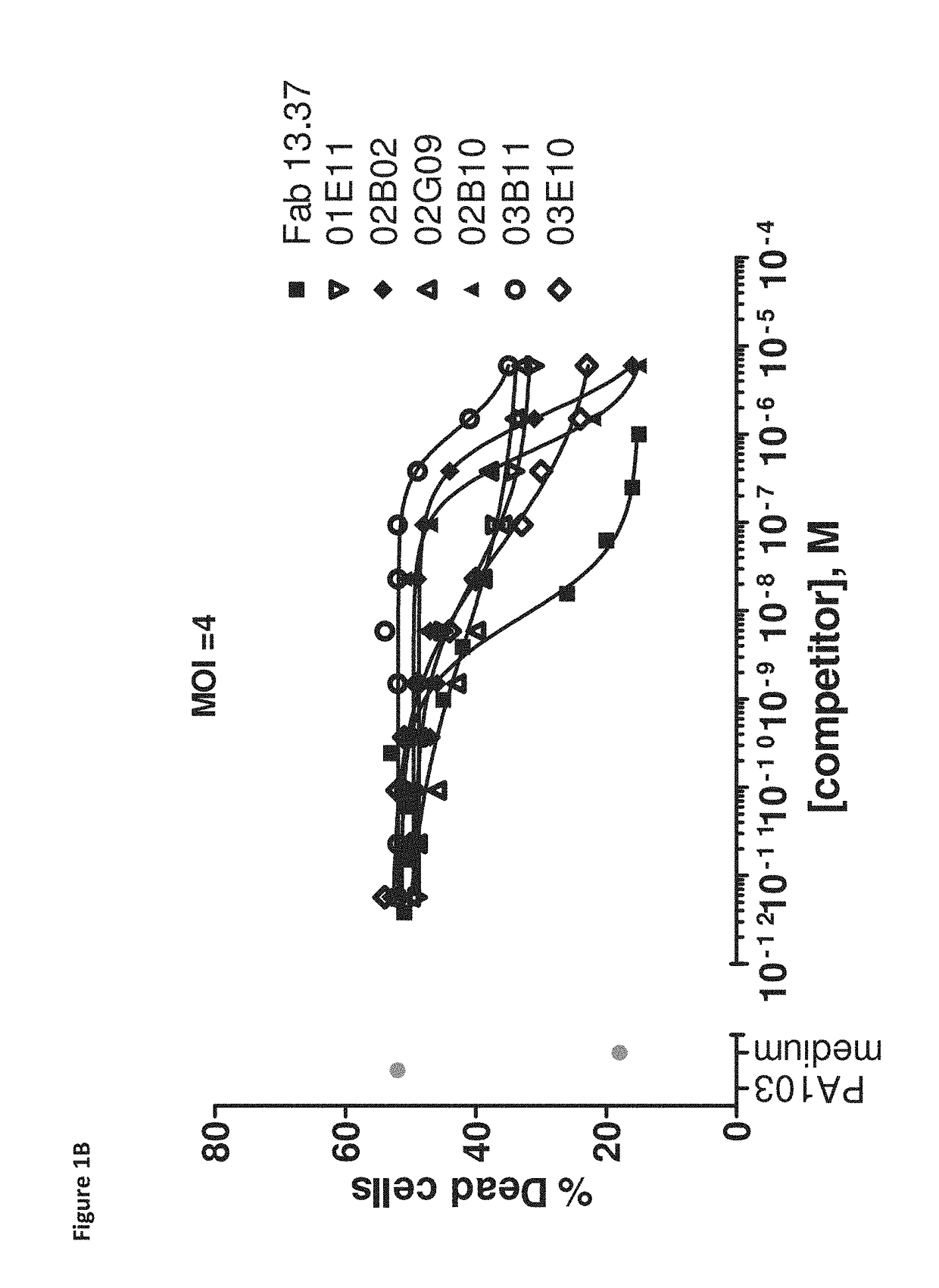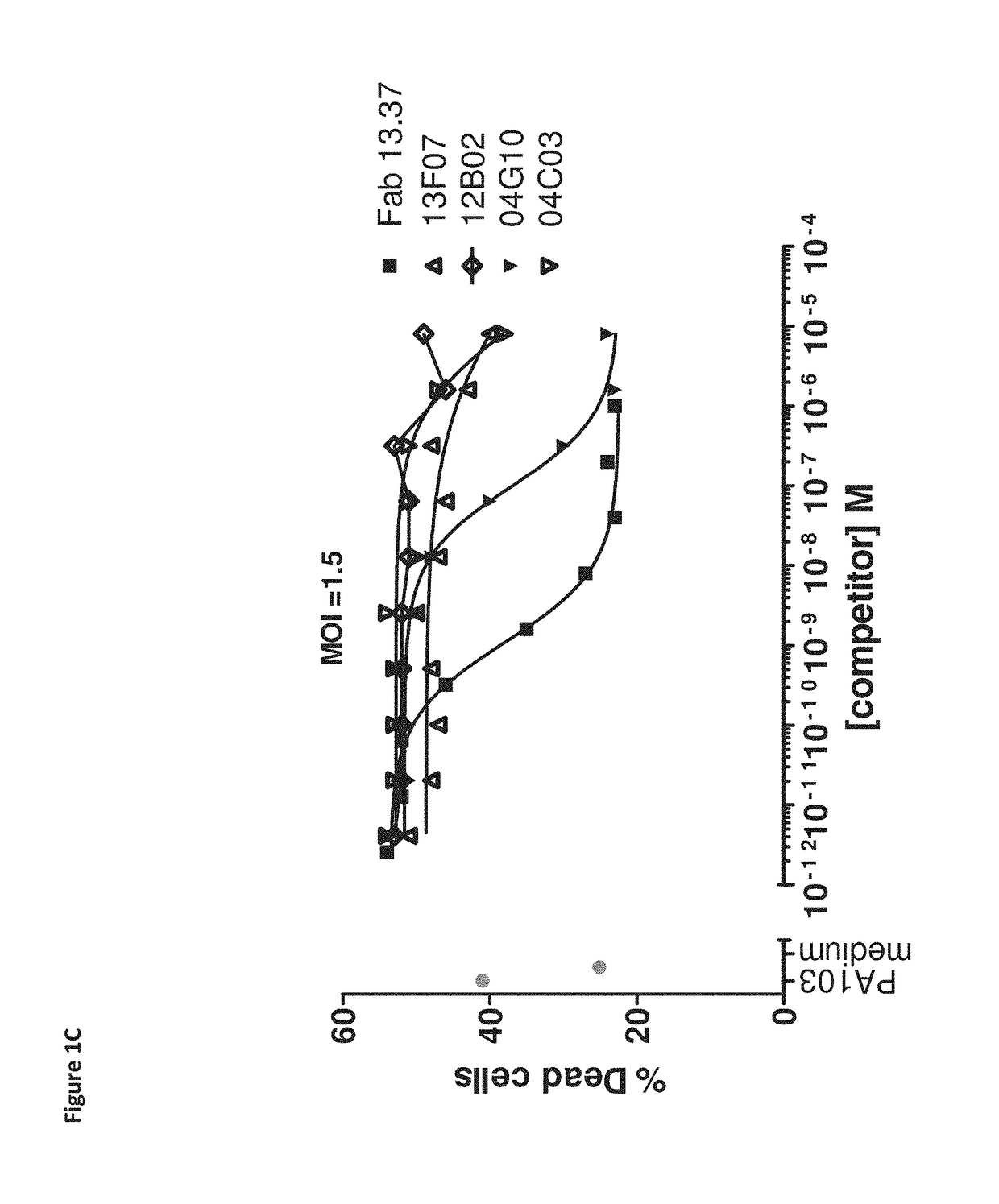Pseudomonas aeruginosa pcrv binding single variable domain antibodies
a technology of pseudomonas aeruginosa and single variable domain, applied in the field of polypeptides, can solve the problems of inability to successfully clear the infection with antibiotics, bacterium can colonise hosts with a weak immune system, and can cause acute lung injury and mortality, etc., to improve the affinity, improve the binding characteristics, and improve the effect of properties
- Summary
- Abstract
- Description
- Claims
- Application Information
AI Technical Summary
Benefits of technology
Problems solved by technology
Method used
Image
Examples
example 1
Materials and Methods
[0705]1.1 Generation of Recombinant PcrV Protein (rPcrV)
[0706]The gene encoding full length PcrV protein of reference strain PAO1 (amino acid residues 1-294, see Table A-1) was cloned into an in house pUC119 derived expression vector. The vector contained the LacZ promoter, a resistance gene for kanamycin, a multicloning site and the pel B leader sequence. In frame with the rPvrV coding sequence, the vector coded for a C-terminal His6 tag. Upon transformation in E. coli (TG-1), expression cultures were grown and expression was induced by addition of 1 mM IPTG and allowed to continue for 4 hours at 37° C. Cells were harvested by centrifugation and cell pellets were lysed by sonication. Cytosolic fractions were isolated by centrifugation. The recombinant protein was purified from the crude extracts via immobilized metal affinity chromatography (IMAC) on HisTrap FF crude 1 ml columns and buffer exchange into D-PBS (HiPrep 26 / 10 column), followed by ion exchange chr...
example 2
ion of Llamas with rPcrV Protein, Cloning of the Heavy Chain-Only Antibody Fragment Repertoires and Preparation of Phage
2.1 Immunizations
[0712]After approval of the Ethical Committee of the faculty of Veterinary Medicine (University Ghent, Belgium), 4 llamas (designated No. 504, 505, 506 and 507) were immunized with 4 intramuscular injections (25 or 10 ug / dose at two weekly intervals) of rPcrV protein formulated in Stimune (Prionics, Lelystad, the Netherlands).
2.2 Cloning of Heavy Chain-Only Antibody Fragment Repertoires and Preparation of Phage
[0713]Following the final immunogen injection, two 150-mL blood samples, collected 4 and 8 days after the last antigen injection were collected per animal. From the blood samples, peripheral blood mononuclear cells (PBMCs) were prepared using Ficoll-Hypaque according to the manufacturer's instructions (Amersham Biosciences, Piscataway, N.J., USA). From the PBMCs, total RNA was extracted and used as starting material for RT-PCR to amplify the ...
example 3
of PcrV Specific VHHs Via Phage Display
[0714]VHH repertoires obtained from all llamas and cloned in phage library were used in two selection strategies. In a first selection strategy, rPcrV protein (in house produced, see Example 1, section 1.1) was immobilized at a concentration of 15 ug / ml on a Nunc Maxisorp plate next to a negative control of 0 ug / ml antigen. Following incubation with the phage libraries and extensive washing, bound phages were eluted with trypsin (1 mg / mL). Eluted phages were amplified and applied in a second round of selection on 10 ug / ml rPcrV and 0 ug / ml (control).
[0715]In a second selection strategy, 50 nM and 5 nM of biotinylated rPcrV protein (bio-rPcrV; biotinylated according to the manufacturer instructions using Sulfo-NHS-LC-Biotin (Pierce, Rockford, Ill., USA)) were captured on a neutravidin coated (1 ug / ml) Nunc Maxisorp plate, next to a negative control of only neutravidin (1 ug / ml). Following incubation with the phage libraries and extensive washing...
PUM
 Login to View More
Login to View More Abstract
Description
Claims
Application Information
 Login to View More
Login to View More - R&D
- Intellectual Property
- Life Sciences
- Materials
- Tech Scout
- Unparalleled Data Quality
- Higher Quality Content
- 60% Fewer Hallucinations
Browse by: Latest US Patents, China's latest patents, Technical Efficacy Thesaurus, Application Domain, Technology Topic, Popular Technical Reports.
© 2025 PatSnap. All rights reserved.Legal|Privacy policy|Modern Slavery Act Transparency Statement|Sitemap|About US| Contact US: help@patsnap.com



